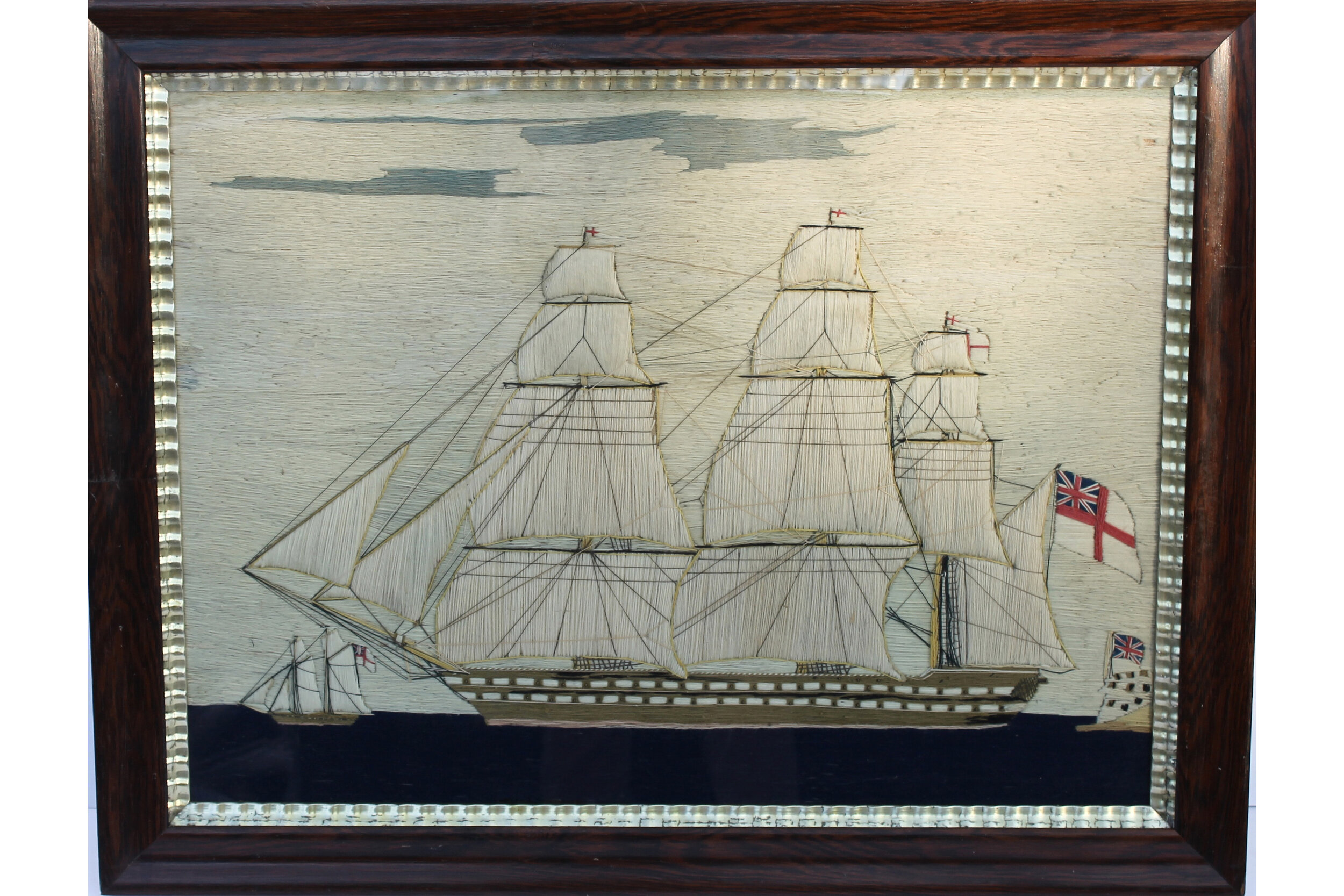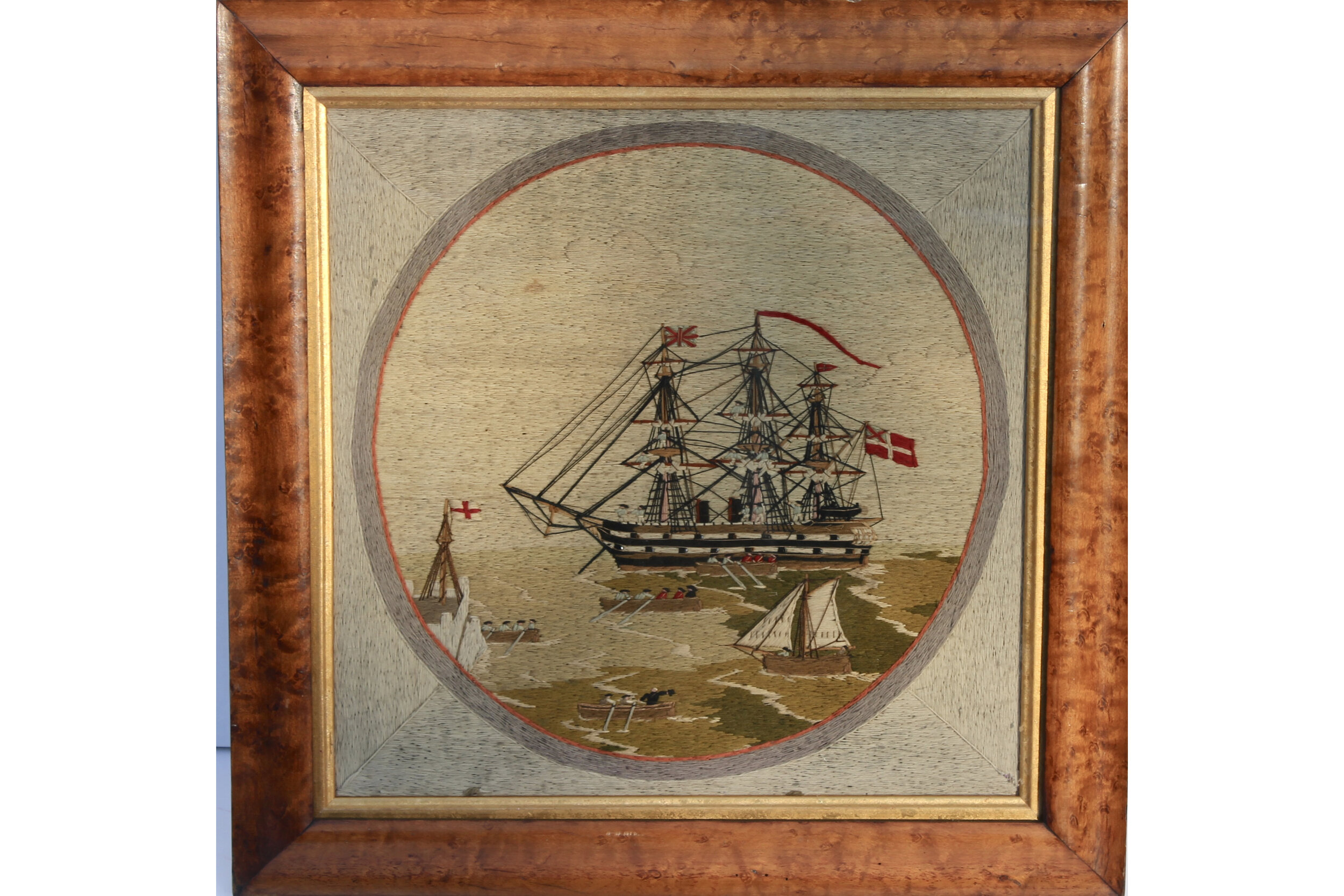Woolworks
The epitome of the British sailors’ artistic endeavors between 1840 and 1890 was found in their remarkable embroidered ships. They were created using a mixture of imagination and a strong knowledge of how ships were constructed, how they sailed and what they looked like from a distance- all of this, added with an ability to sew, resulted in hundreds of “woolies” created by several hundred unknown sailors.
Most sailors in these times needed to know how to sew. They were expected to sew their own clothes, fix buttons etc… and be able to repair the ships’ sails when they were ripped and torn. Often they would embroider their own jackets with designs and personal embellishments.
These 19th century pictures were created on a piece of stretched sail canvas. The sailor-artist would sketch out his intended design on the canvas which would be stretched and supported by a piece of wood on each of the two shorter sides which would enable him to roll it up and stash it away easily when not being worked on. After the picture was finished and the ship had returned to port, a more permanent frame would be made.
While sailors were somewhat adept at basic needle working skills, it is interesting to note the completely different stitches that different sailors utilized. Many of the earlier woolworks tend to have a very time consuming chain stitch where every stitch seems to go into the stitch before and it is less than a one -quarter of an inch long. Later, the stitches became a much faster long and short stitch which could go form many inches at a time covering the canvas with a long stitch quickly and taking only a short stitch in the back before coming in front again.
The sailors knew their ships and were very knowledgeable about the rigging and the sails. Their rigging work was accurate and completed with long stitches- usually of a finer thread than the rest of their work. Often they would use silk or thin twisted gold threads together for these sail lines. Often changes in color design dictated the length and style of stitches. The sailor might change thread directions for different effects.
Obviously, some sailors were more expert than others, as evidenced in the elaborate details in some woolies versus the simpler broadside portraits, which are the majority. Most were probably creative portraits of the sailor’s own ship. It is when a sailor went beyond the portrait stage that these woolworks take on new dimensions and interest and one can see how talented many of these men were.
Sailors showed their skills when they included some of the following: scenes of faraway ports, sea battles, rough seas and ships in distress, forts and lighthouses, flags of other countries, flags and small vignettes incorporated in center portholes, symbols of the royal family such as beadwork crowns or the British motto under the coat of arms with a lion rampant and a white unicorn, gold threads in the flag showing a Royal family member was aboard ship, a vine with roses for England, thistles for Scotland, shamrocks for Ireland, Crimean War symbols of cannons and pyramids of cannon balls, whimsical visions of full suns in bright golden threads, a full moon at night with stars around, a skull and crossbones flagged pirate ship, house filled harbors, or foreign cities such as Canton, or Naples with Mt. Vesuvius erupting, fully dresses ships with all the colorful flags in celebration, the ship’s name included either in stitch, or on a silk work or painted sailor’s hatband, the cannons of a warship made from ins, small nails or beads, the portholes fitted with mica chips to reflect, a lifeboat off the side of a ship in a storm made out of thin wood strips as salt crystals as hail attack the ship, mountains with white sides showing glaciers of ice around Cape Horn, the use of beads and silk work for highlights and details, tassels emphasizing curtain effects, sails of multi colors showing their waves and gullies, patterned skies with heavier stitched clouds, shields in corners resembling different countries’ flags, flowers in vines encircling ships, and last but not least a sailor’s farewell leaving his sweetheart with a ship in the background.
On the whole, these woolworks were great examples of the British folk artists who as sailors transformed long hours, days and weeks on ships into some kind of creative endeavor, which took little space but allowed them a wonderful outlet for their obvious talents. These marvelous pictures were done for pure pleasure, there was no profit motive and little recognition. Out of hundreds seen, only three are known to include information regarding the maker.
It is surprising that American sailors did not often involve themselves in similar pursuits. Their attentions seem devoted to doing more scrimshaw. There are some American flagged woolies, but they are few, rare and desirable. It would be hard to imagine a British sailor doing a primarily American ship, but with no documentation, it is hard to be sure.
To be sure that a woolwork is of the correct period, there are a few clues. Since they have become very popular, some industrious British are finding it profitable to create them today. If anyone wants to learn about them or to purchase them, be in touch with someone who is knowledgeable and will guarantee their authenticity. Otherwise, insist on seeing the reverse side since no one has yet figured out how to fade the front, which inevitably has faded in sunlight over time. The back wool colors will always be far brighter than those in front. There might be some evidence of a little moth damage along the outer edges when the picture may not have been framed and sealed. Also, old canvases are just that and new ones being used are thinner, often of fabric or cloth, not canvas and have no signs of age discoloration.
Sometimes when a woolwork seems to good to be true, it just might be.

#2. Strong Puffed Sails, American flagged ship, 2 lighthouses. $11,000

#4. Great use of reds in flags, lighthouse, house and second ship. 28 3/4" x 24". $4000

#5. 34 2/2" x 25 1/2". $3000

#6. 39" x 26 3/4". Fabulous work- flags, Britannia, curtains, crown, wreathed circle, two small ships, roses ...$9500

#8. 28 1/2" x 20 1/4". nice sea. $2800

#9. 23 1/2" x 20 1/2". Different with the photograph of the young boy. $2200

#10. 25 1/2" x 24". Very nice design and effective colors. Includes flags, curtains, lighthouse at lower right, another bat at lower left. $6000

#11. 27 1/2" x 23". Striated sea, light green-blue sky, puffed sails. 27 1/2" x 23". $2400

#12. 25 1/2" x 22 1/2". Really rare ship in storm with porthole device. $3750

#13. 29" x 20 1/2". Rare named ship "Fiery Cross". Tall ship with sun at upper right, town on left. $3200

#16. 23 1/2" x 19 1/4" Flags and rose, thistle, shamrocks below with motto banner. Crown at top. Center beat in porthole. $3400

#17. 23 1/2" x 20" Central with sails down. Unusual shields in corners designating different countries. $2400

#18. 36" x 24 3/4". HMS THETIS. Terrific one with name, anchors and gunports, and harbor scene with forts, land and lighthouse. Bad reflection from camera- perfect condition. $8500

#19. 25 1/2" x 20 1/2". Great scene with ship off cliffs in wavy seas. Great water. $4800

H.M.S.Raccoon. Unusual with the name and the extra boats in the scene. 21" x 16" C. 1870 $2850

Thirty gun ship with nice use of blues in the water and the skies and beads for guns. 22" x 17 1/4" C. 1870 $2500

a6a.Ship of the line passing a coastal fortification with an accompanying Royal Navy brig. 29" x 22 1/2". $5000

a68.Porthole design with wonderful picture of sailors and soldiers in rowboats and on the central ship and even in the masts. Great design and detail. 17" x 17". $3500